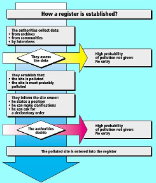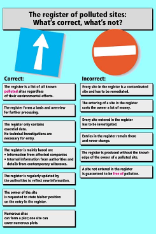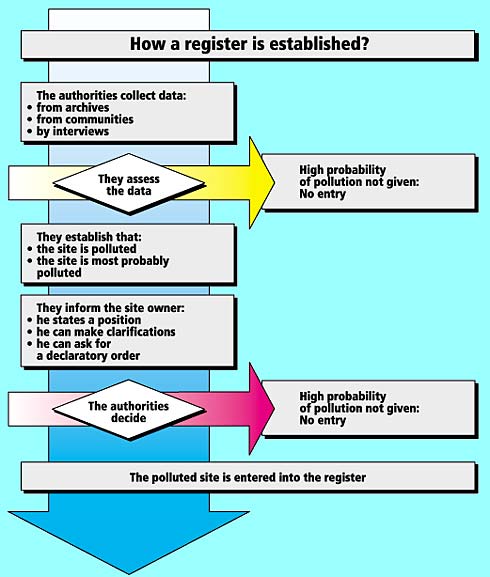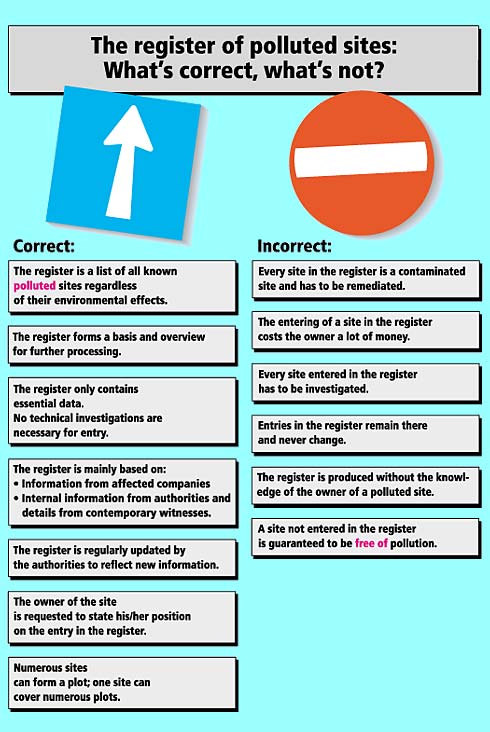Registration of the polluted sites, initial assessment
What is the purpose of the register of polluted sites?
- As an information instrument that lists existing pollutions, thus preventing waste-polluted sites from going unnoticed and endangering the environment.
- As a planning instrument in service to cantonal environmental authorities (e.g., contaminated sites management, water protection, regional planning).
- For dividing recorded sites into harmless sites and those that must be investigated further.
- To pinpoint any acute hazards to the environment requiring immediate action.
- To speed up action in the case of sites requiring investigation where pollution potential and release potential, as well as the natural resources, must be considered.
- As orientation for those affected such as site owners, developers, real estate agents, banks, insurance companies and neighbours. The register serves as basis for an objective evaluation of a property; construction projects can be adapted in good time to the facts and surprises that lead to halting or delaying construction are avoided.
All polluted sites such as waste disposal sites and company or accident-related sites are entered in the register maintained by the cantonal office in charge. In order that the owner of the property or the company not be Subjected to the whims of the canton, the canton is obliged to inform the owner prior to recording a site in the register. The owner receives the opportunity to take a position regarding the project at that time or to make additional clarifications. The authorities are also empowered to get information from the owner concerning the site.
The publically accessible register is not only intended to contribute to general transparency and clear relationships. It is also intended to help minimise today's insecurities in construction project planning, property transactions or loan procedures where polluted sites are concerned.
Banks in particular (in approving loans) and insurance companies are known to be very cautious at times due to the potential pollution risks. But just because a site is entered into the register doesn't mean the time has come for alarm bells to ring. For many of these sites the potential "environmental costs" of the pollution can be fairly exactly estimated, e.g., in cases of polluted sites that require neither remediation nor monitoring and at which only a known amount of waste would have to be separated and disposed of in the context of a construction project.
Once registered - always registered?
Here, too, there is no cause for alarm: The register is a dynamic working instrument being adapted to new information on an ongoing basis. A site must be removed from the register as soon as it turns out that it is not or is no longer polluted with waste. And new investigation and remediation results are to be updated continuously.
According to applicable regulations, the only sites to be entered in the register are those polluted with waste or those where there is probable cause to expect that they are polluted. The requisite clarifications are more or less complicated depending on the type of site:

How a register is established?
For a waste disposal site, a landfill, the case is pretty clear. Basically, there will always be waste found here. For years the cantons have maintained landfill registers that contain valuable information. As an exception to the rule waste disposal sites exclusively storing unpolluted excavation material do not belong in the register.
Entering a site is also relatively simple in the case of accident sites as in most cases such accidents are already entered into a damage claims register. In some cases the polluted material was disposed of immediately or the event lies so far in the past that the pollutants are already nearly completely degraded or evaporated and thus there is no longer any environmental hazard present.
The systematic recording of company sites is already more difficult, requiring a closer collaboration between authorities and site owner as a rule. Clarifications of a suspicion of pollutants or the possibility of entry in the register of a company site must be approached pragmatically and in a sector-specific manner.
Thus, while many sectors do not crop up in relation to contamination (e.g., banks, department stores, butchers, hairdressers), the operations taking place in other sectors are much more likely to (e.g., gas works, galvanizing operations, dry cleaning, paint and varnish companies, shooting ranges). Membership in a sector alone, however, is not enough to be entered in the register. The following questions, among others are of significance:
- Were environmentally hazardous substances used at all?
- How long and when was the company in production?
- What pollutants can be expected and in what quantities?
- Could the pollutants have entered the subsoil at all?
These questions don't always cover the issues, however: At new operations (new storage tanks and petrol stations, modern chemical factories) for example, often no pollution of the subsoil is to be expected due to stricter regulations and the development of more effective protective measures. And contamination-relevant sectors such as gas supply cannot be recorded en masse as a sector because risk-free areas, such as administration buildings, are also part of their business. In addition, demolition debris backfills around villas don't belong in the register.

The register of polluted sites: What's correct, what's not?
Further information
Documents
Aids to enforcement
Erstellung des Katasters der belasteten Standorte
Last modification 11.07.2023







